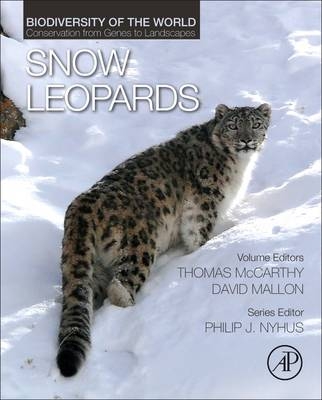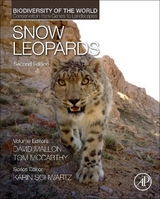
Snow Leopards
Academic Press Inc (Verlag)
978-0-12-802213-9 (ISBN)
- Titel erscheint in neuer Auflage
- Artikel merken
Breakthroughs in technologies and methodologies to study this elusive cat have come rapidly, including non-invasive genetics, camera traps, and GPS-satellite collaring. The book begins with chapters on the genetic standing and taxonomy of the snow leopard, followed by chapters on their behavior and ecology. Additional contributions follow on the current and emerging threats to the species, which include longstanding concerns, such as poaching and conflicts with livestock, and new and emerging threats such as mining and climate change.
A section on conservation solutions, backed by valuable case studies, starts with an overview of the important role mountain communities play in assuring the snow leopard’s long-term persistence. In addition, chapters on the role of captive snow leopards for the conservation of the species, state-of-the-art techniques and technologies for studying and monitoring snow leopards, status reports from around the region, and future perspectives, such as transboundary conservation initiatives, international conventions (CITES, CMS, etc.), the role of the IUCN Cat Specialist Group and the Snow Leopard Network, and undertakings such as the Global Snow Leopard Forum facilitated by the World Bank are also included.
Philip Nyhus is the Director of the Environmental Studies Program at Colby College in Maine, Maine, US. His interdisciplinary research bridges the natural and social sciences to address human interactions with the environment, including endangered species conservation and recovery, human-wildlife conflict, large landscape conservation, and spatial modelling. He is co-editor of Tigers of the World: The Science, Politics and Conservation of Panthera tigris (2010). Dr. Tom McCarthy, Panthera’s Director of Snow Leopard Programs, began his conservation career studying brown bears, black bears, mountain goats and caribou in Alaska in the early 1980s. A strong interest in international conservation led him to Mongolia in 1992, where, under the guidance of Dr. George Schaller (known as “one of the founding fathers of wildlife conservation), he took over the management of a long-term snow leopard research project. He was the first biologist to use satellite radio-collars on snow leopards. McCarthy became the Science and Conservation Director of the Snow Leopard Trust in 2000 and has since led their extensive science and community-based conservation programs across much of snow leopard range in Asia. From 2002-2009, Dr. McCarthy served as Executive Director of the Snow Leopard Network, a global consortium of more than 200 professionals involved in snow leopard research and conservation. Among other research initiatives, Dr. McCarthy is leading both a range-wide assessment of snow leopard genetics that seeks to identify movement corridors which are critical to maintaining the health and genetic diversity of the species, and a revision of methods by which snow leopard populations can be monitored over time, including such novel non-invasive approaches as fecal genetics, camera trapping and statistical modeling based on sign surveys. Dr. David Mallon is not only a recognized expert on snow leopards, he is extremely knowledgeable on the conservation status of Central Asia as a whole. He conducted some of the early assessments of the status of snow leopards in Mongolia and has done surveys in many of the Himalayan range states. He has more than 25 years of field work experience in the Himalaya, Tibetan Plateau, Mongolia, Central Asia and Arabia, mainly focused on large mammals, and involving species surveys, biodiversity assessment, habitat assessment, camera trapping, training, capacity building, and training local partners in census and monitoring techniques. He is a Fellow of the Royal Geographical Society and the Zoological Society of London, as well as a member of the International Editorial Board for Oryx, the International Journal of Conservation. He has been a Steering Committee member of the Snow Leopard Network since its inception in 2003 and is currently the elected Chairman of that 400 member organization, which represents nearly every biologist and conservationist now active in the snow leopard world. He is highly respected among his peers as an expert on this cat.
Section I - Defining the Snow Leopard
1 What Is A Snow Leopard? Taxonomy, Morphology, and Phylogeny
2 What Is A Snow Leopard? Behavior and Ecology
3 What Is A Snow Leopard? Biogeography and Status Overview
4 Snow Leopard’s Prey and Diet
Section II - Conservation Concerns
5 Livestock Predation by Snow Leopards: Conflicts and the Search for Solutions
6 Living on the Edge: Depletion of Wild Prey and Survival of the Snow Leopard
7 Monitoring Illegal Trade in Snow leopards (2003-2012)
8 Climate Change Impacts on Snow Leopard Range
9 Diseases of Free-ranging Snow Leopards and Primary Prey Species
10 Resource Extraction
10a Introduction
10b Emerging Threats to Snow Leopards from Energy and Mineral Development
10c Linear Infrastructure and Snow Leopard Conservation
10d Harvesting of Caterpillar Fungus and Wood by Local People
10e Synthesis
Section III - Conservation Solutions In situ
11 The Role of Mountain Communities in Snow Leopard Conservation
12 Building Community Governance Structures and Institutions for Snow Leopard Conservation
13 Incentive and Reward Programs in Snow Leopard Conservation
13a Himalayan Homestays: Fostering Human-Snow Leopard Coexistence
13b Handicrafts - Snow Leopard Enterprise in Mongolia
13c A Review of Lessons, Successes and Pitfalls of Livestock Insurance Schemes
13d Synthesis
14 Livestock Husbandry and Snow Leopard Conservation
14a Corral Improvements
14b The Role of Village Reserves in Revitalizing the Natural Prey Base of the Snow Leopard
14c The Ecosystem Health Program: A Tool to Promote the Co-Existence of Livestock Owners and Snow Leopards
14d Synthesis
15 Religion and Cultural Impacts on Snow Leopards Conservation
15a Introduction
15b Tibetan Buddhist Monastery-based Snow Leopard Conservation
15c Shamanism in Central Asian Snow Leopard Cultures
15d Snow Leopards in Art and Legend of the Pamir
15e The Snow Leopard in Symbolism, Heraldry and Numismatics: The Order "Barys" and Title "Snow Leopard"
16 Trophy Hunting as a Conservation Tool for Snow Leopards
16a The Trophy Hunting Program: Enhancing Snow Leopard Prey Populations through Community Participation
16b Argali Sheep (Ovis ammon) and Siberian Ibex (Capra sibirica) Trophy Hunting in Mongolia
16c Hunting of prey species - a review of lessons, successes and pitfalls. Experiences from Kyrgyzstan and Tajikistan
16d Synthesis
17 Environmental Education for Snow Leopard Conservation
18 Law Enforcement in Snow Leopard Conservation
19 Transboundary Initiatives and Snow Leopard Conservation
20 Corporate Business and the Conservation of the Snow Leopard: Worlds that Need not Collide
Section IV - Conservation Solutions Ex situ
21 The Role of Zoos in Snow Leopard Conservation: Management of Captive Snow Leopards in the EAZA Region
22 The Role of Zoos in Snow Leopard Conservation: The Species Survival Plan in North America
23 The Role of Zoos in Snow Leopard Conservation: Captive Snow Leopards as Ambassadors of Wild Kin
23a Kolmården Wildlife Park: Supporting Snow Leopards in the Wild, Sharing the Message at Home
23b Woodland Park Zoo: From a Zoo Came a True Snow Leopard Champion
23c Bronx Zoo: Ambassadors from the Roof of the World
24 Rescue/rehab Centres and Reintroductions to the Wild
24a Tigers, Lynx and Jags: Implications for Snow Leopards
24b The NABU Kyrgyz Experience
Section V - Techniques and Technologies for the Study of a Cryptic Felid
25 Snow Leopard Research: A Historical Perspective
26 From VHF to Satellite GPS Collars: Advancements in Snow Leopard Telemetry
27 The Role of Genetics
27a Conservation Genetics of Snow Leopards
27b Diet Reconstruction of Snow Leopard Using Genetic Techniques
28 Camera Trapping: Advancing the Technology
29 Landscape Ecology: Linking Landscape Metrics to Ecological Processes
Section VI - Snow Leopard Status and Conservation: Regional Reviews and Updates
30 Central Asia: Afghanistan
31 Central Asia: Kyrgyzstan
32 Central Asia: Kazakhstan
33 Central Asia: Tajikistan
34 Central Asia: Uzbekistan
35 South Asia: Bhutan
36 South Asia: India
37 South Asia: Nepal
38 South Asia: Pakistan
38a Snow Leopard Conservation in Pakistan: A Historical Perspective
38b The Current State of Snow Leopard Conservation in Pakistan
39 Northern Range: Mongolia
40 Northern Range: Russia
41 China: The Tibetan Plateau, Sanjiangyuan Region
42 China: Current State of Snow Leopard Conservation in China
Section VII - The Future of Snow Leopards
43 Sharing the Conservation Message
44 Global Strategies for Snow Leopard Conservation: A Synthesis
45 The Global Snow Leopard and Ecosystem Protection Program
46 Joining Up the Spots: Aligning Approaches to Big Cat Conservation from Policy to the Field
47 Future Prospects for Snow Leopard Survival
| Erscheinungsdatum | 22.08.2016 |
|---|---|
| Reihe/Serie | Biodiversity of the World: Conservation from Genes to Landscapes |
| Mitarbeit |
Herausgeber (Serie): Philip J. Nyhus |
| Verlagsort | San Diego |
| Sprache | englisch |
| Maße | 191 x 235 mm |
| Gewicht | 1470 g |
| Themenwelt | Naturwissenschaften ► Biologie ► Ökologie / Naturschutz |
| Naturwissenschaften ► Biologie ► Zoologie | |
| ISBN-10 | 0-12-802213-2 / 0128022132 |
| ISBN-13 | 978-0-12-802213-9 / 9780128022139 |
| Zustand | Neuware |
| Informationen gemäß Produktsicherheitsverordnung (GPSR) | |
| Haben Sie eine Frage zum Produkt? |
aus dem Bereich



